6. Muscule 2
1/37
There's no tags or description
Looks like no tags are added yet.
Name | Mastery | Learn | Test | Matching | Spaced |
|---|
No study sessions yet.
38 Terms
What does muscular system specifically refers to?
Skeletal muscles
What are fascicles in skeletal muscle?
Fascicles are bundles of muscle fibers within skeletal muscle, large enough to be seen without magnification.
The alignment of fascicles differs depending on the muscle and its specific function, with various muscles having different patterns of fascicle arrangement.
The arrangement of fascicles can reveal important details about a muscle's function, such as its range of motion and the amount of force it can generate.
What are different types of arrangements of fascicles?
There are several types of fascicle arrangements in skeletal muscles, each influencing the muscle’s function, strength, and range of motion:
Circular
Convergent
Parallel
Pennate (Multipennate, bipennate, unipennate)

What is the characteristic alignment of fascicles in muscles with a circular arrangement, and what function do they serve?
In circular muscles, fascicles are arranged in concentric rings. These muscles surround body openings and contract to close the openings, as seen in muscles like the orbicularis oris (around the mouth) and orbicularis oculi (around the eyes).
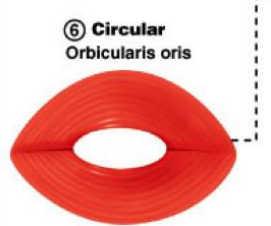
How does the convergent arrangement of fascicles affect muscle function, and can you provide an example of a muscle with this pattern?
In a convergent muscle, fascicles have a broad origin and converge toward a single tendon of insertion, creating a fan or triangular shape. The muscle fibers extend from the broad origin all the way to the point of insertion. An example of a convergent muscle is the pectoralis major, where fibers extend from the chest to insert on the humerus, allowing the muscle to perform actions such as flexion, adduction, and rotation of the arm.
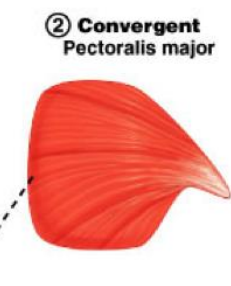
What defines the parallel arrangement of fascicles?
In parallel muscles, fascicles run parallel to the long axis of the muscle, extending from origin to insertion. This arrangement allows for greater range of motion but less force.
What is the fusiform arrangement of muscle fascicles, and how does it differ from strap-like muscles? Can you provide examples of each?
In a fusiform muscle, the fascicles are arranged in a way that the muscle has an expanded central belly that tapers towards the origin and insertion, allowing for greater force generation. An example of a fusiform muscle is the biceps brachii.
In contrast, strap-like muscles have long, thin fascicles that run parallel to the long axis of the muscle without an expanded belly, providing greater range of motion but less power. An example of a strap-like muscle is the sartorius in the lower limb.

How are fascicles arranged in pennate muscles, and how does this affect the muscle’s power and range of motion?
In pennate muscles, fascicles are short and attach obliquely to a tendon that runs along the length of the muscle, giving a feather-like appearance. Pennate muscles are powerful but have a limited range of motion.

What is the difference between unipennate, bipennate, and multipennate muscle arrangements, and can you give an example of each?
In unipennate muscles, fascicles insert into one side of the tendon, as in the extensor digitorum longus (anterior (extensor) compartment of leg).
In bipennate muscles, fascicles insert into the tendon from both sides, as seen in the rectus femoris (quadriceps muscle that crosses the hip and knee joints).
Multipennate muscles have several "feather-like" fascicle arrangements side by side, as in the deltoid (rounded contour of the human shoulder), creating a powerful but restricted range of motion.

What does arrangement of fascicles influences?
• Amount of movement produced when contracted-i.e. range of motion
• Amount of force-i.e. its power
How much can skeletal muscle fibers shorten when they contract?
Skeletal muscle fibers can shorten by up to one third of their original length during contraction.
How does the number of muscle fibers affect a muscle’s power?
A muscle’s power depends on the total number of fibers it contains. Muscles with many short fibers, like those in bipennate and multipennate arrangements, generate more power because they have a greater number of fibers contributing to the contraction, even though they have less range of motion.
What is the relationship between the alignment of muscle fibers and the range of motion a muscle can achieve?
The more parallel the fibers are to a muscle's long axis, the more the muscle can shorten, resulting in a larger range of motion. However, this arrangement typically generates less power.
How are muscles grouped in relation to their actions?
Muscles are grouped according to their action at specific joints or in producing specific movements.
Why can't muscles "push" or reverse the action they produce?
Muscles cannot "push" because they can only contract to pull on bones, which generates movement in one direction. To reverse the action, a different muscle or muscle group is required to pull in the opposite direction.
Where are groups of muscles that produce opposite functions typically located in relation to a joint?
Groups of muscles that produce opposite functions lie on opposite sides of the joint. For example, the biceps brachii and triceps brachii are on opposite sides of the elbow joint, producing flexion and extension, respectively.
What is the role of an agonist in muscle contraction and can you provide an example of an agonist and its specific movement?
The agonist, or prime mover, is primarily responsible for generating a specific movement by contracting to produce that motion.
An example of an agonist is the biceps brachii, which acts as the prime mover during elbow flexion.
What is the role of an antagonist in muscle contraction and can you provide an example of an antagonist and its specific movement?
The antagonist muscle opposes the action of the agonist, helping to control the extent and speed of the movement, ensuring smooth and coordinated actions. An example of an agonist is the triceps brachii, which acts as the antagonist during elbow flexion. Antagonists can be prime movers in their own right
What is the significance of having both agonist and antagonist muscles develop evenly?
It is important for both muscles to develop evenly to prevent excessive tension on the joint
What is the role of a synergist in muscle contraction and can you provide an example of a synergist and its specific movement?
A synergist assists the agonist in generating movement, providing additional force at the insertion point or stabilizing structures near the origin. An example of a synergist is the teres minor, which assists the latissimus dorsi during the initial downward movement of the arm

What is the role of a fixators in muscle contraction and can you provide an example of a fixators and its specific movement?
Fixators stabilize the proximal end of a structure while the action occurs at the distal end, allowing for controlled and effective movements. An example of a fixator is wrist joint is fixed during flexion of fingers
Why is it important to recognize the roles of antagonists and synergists, even though prime movers receive most of the credit?
Recognizing the roles of antagonists and synergists is important because they contribute significantly to the quality of movement, stability, and control, which are crucial for effective and safe muscle function.
What role does the design of the joint, skeleton, and muscles play in movement?
The design of joints, skeletons, and muscles determines the extent (how far), force (how much), range (how many angles), direction (which way), and speed (how quickly) movements can occur in the body.
What are anatomical pulleys, and what is their purpose in muscle movement?
Anatomical pulleys are structures (like bones or tendons) that change the direction of the force applied by a muscle, enhancing efficiency and control of movement.
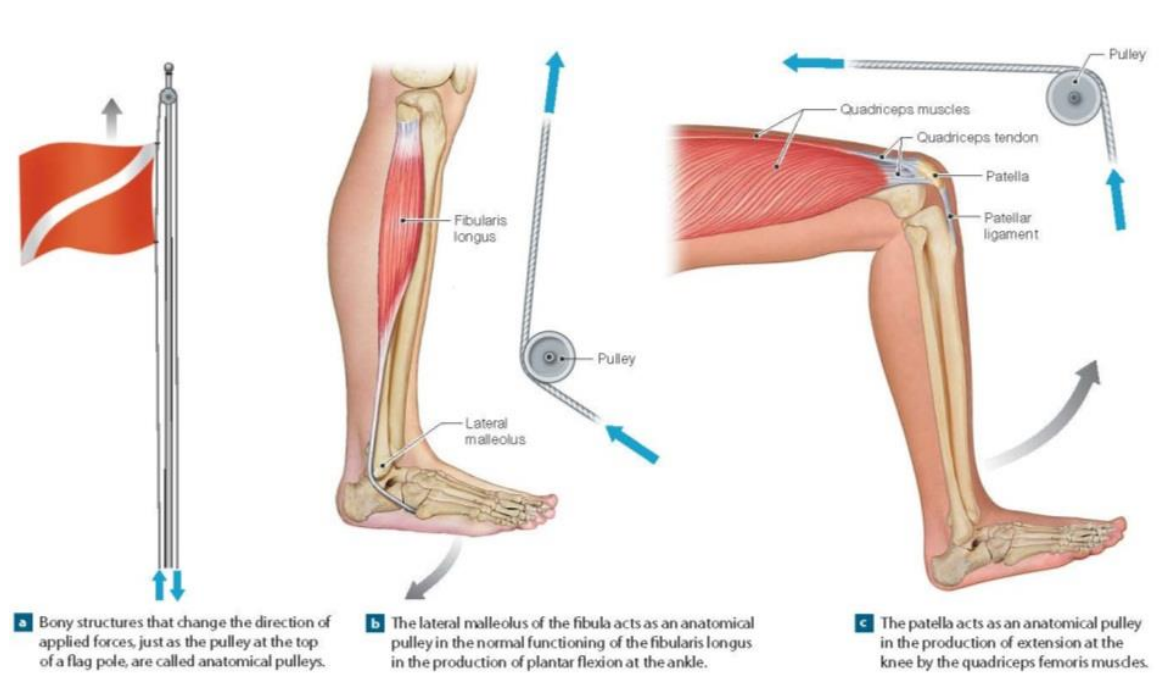
What is a lever and fulcrum?
A lever is a rigid structure (like a bone) that moves around a fixed point called a fulcrum (the joint).
How do applied force and resistance interact in a lever system, and what is their significance in producing movement?
In a lever system, the applied force is the force generated by muscle contraction, which works to move a body part. The resistance is the opposing force, often the weight of the body part being moved. These two forces interact to produce movement: the applied force must overcome the resistance for movement to occur.
What are the three different classes of levers, and how do they differ from one another?
The three classes of levers are:
Class I: The fulcrum is between the applied force and the resistance (e.g., nodding the head).
Class II: The resistance is between the fulcrum and the applied force (e.g., standing on tiptoes).
Class III: The applied force is between the fulcrum and the resistance (e.g., lifting a weight with the biceps).

How does aging affect skeletal muscle?
Reduced fibre diameter
– Reduced metabolism leads to reduced strength and endurance
– Increased fatigue
• With age, cardiac muscle also slows down therefore blood flow cannot compensateMuscles become smaller and less elastic
– Increased fibrous connective tissue replaces space previously occupied by fibres (fibrosis).Tolerance for exercise is reduced
– Reduced metabolism
– Reduced capacity to eliminate the heat generated during exerciseReduced ability to heal
– Damaged tissue is not replaced by new muscle but replaced with fibrous connective
tissue
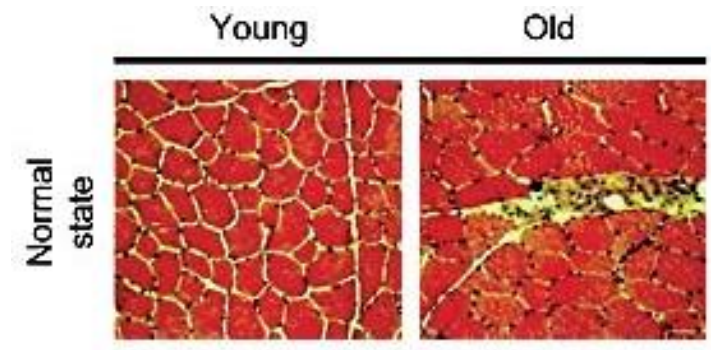
How does reduced metabolism contribute to decreased strength and endurance in older adults?
Reduced metabolism leads to lower energy production, which negatively impacts muscle function. With less energy available, muscle fibers cannot contract as effectively, resulting in decreased strength and endurance during physical activities.
How does the slowing down of cardiac muscle with age impact overall blood flow in the body?
As cardiac muscle slows down with age, the heart may pump less effectively, resulting in reduced blood flow. This can affect the delivery of oxygen and nutrients to muscles and organs, impairing physical performance and recovery, especially during exert. Feeling fatigue when exercising
What is myopathy?
Myopathy refers to any disorder that affects muscle tissue
What are muscular dystrophies?
Muscular dystrophies are a group of mostly inherited disorders characterized by the progressive degeneration of muscle fibers
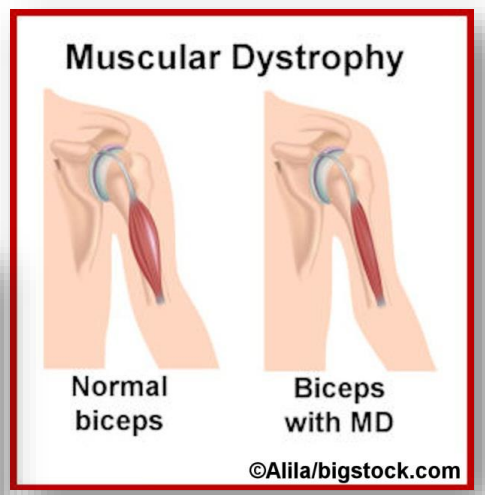
How does myofascial pain syndrome manifest, and what triggers the pain?
Myofascial pain syndrome is characterized by pain resulting from fascial constriction around muscles, often leading to localized muscle tenderness and pain. Trigger points can cause twitching in the muscle when the skin is touched, resulting in discomfort.
What are strains, and how do they affect muscles and tendons?
Strains are injuries that occur to muscles or tendons, often resulting from overstretching or excessive force. They can cause pain, swelling, and limited mobility, depending on the severity of the injury.
What causes shin splints, and what happens to the tibial periosteum during this condition?
Shin splints occur when the tibial periosteum becomes inflamed, often due to overuse or increased activity that the muscles cannot tolerate.
What is tenosynovitis, and what structures does it affect?
Tenosynovitis is the inflammation of the tendon sheaths and the synovial membranes that surround tendons. This condition can cause pain and swelling in the affected area, often limiting movement.
How does tendinitis differ from tenosynovitis in terms of inflammation?
Tendinitis specifically refers to the inflammation of a tendon itself, while tenosynovitis involves inflammation of the tendon sheath surrounding the tendon.
What is the role of tetanus and Botox in muscle contraction and relaxation?
Tetanus refers to a sustained muscle contraction caused by rapid stimulation, resulting in a prolonged state of contraction. Botox, derived from Clostridium botulinum, causes total relaxation of muscles by blocking nerve signals, effectively preventing contraction and reducing muscle activity.